Change in tetrapod posture across the Permo-Triassic boundary
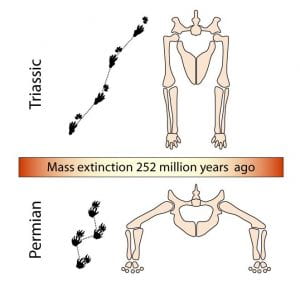 The end-Permian mass extinction, 252 million years (myr) ago, marked a major shift in the posture of tetrapods. Before the mass extinction, terrestrial tetrapods were sprawlers, walking with their limbs extended to the sides; after the event, most large tetrapods had adopted an erect posture with their limbs tucked under the body. This shift had been suspected from the study of skeletal fossils, but had been documented as a long process that occupied some 15-20 million years of the Triassic.A new study by Tai Kubo of the University of Tokyo and Mike Benton of the University of Bristol has shown that the process was much faster, and the sprawling to erect posture happened right at the Permo-Triassic boundary (PTB), 252 million years ago. The new study was based on the direct evidence of fossil footprints. The track record is richer than the skeletal record, especially for the Early and Middle Triassic intervals, the critical 20 million years during which period the postural shift occurred. The shift to erect posture was completed within the 6-7 million years of the Early Triassic and affected both lineages of medium to large tetrapods of the time, the diapsids and synapsids.
The end-Permian mass extinction, 252 million years (myr) ago, marked a major shift in the posture of tetrapods. Before the mass extinction, terrestrial tetrapods were sprawlers, walking with their limbs extended to the sides; after the event, most large tetrapods had adopted an erect posture with their limbs tucked under the body. This shift had been suspected from the study of skeletal fossils, but had been documented as a long process that occupied some 15-20 million years of the Triassic.A new study by Tai Kubo of the University of Tokyo and Mike Benton of the University of Bristol has shown that the process was much faster, and the sprawling to erect posture happened right at the Permo-Triassic boundary (PTB), 252 million years ago. The new study was based on the direct evidence of fossil footprints. The track record is richer than the skeletal record, especially for the Early and Middle Triassic intervals, the critical 20 million years during which period the postural shift occurred. The shift to erect posture was completed within the 6-7 million years of the Early Triassic and affected both lineages of medium to large tetrapods of the time, the diapsids and synapsids.
The posture shift, from sprawling to upright, 252 million years ago. Drawing by Simon Powell, copyright.
Posture and trackways
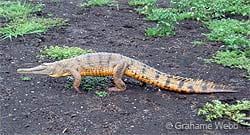 It probably seems rather obvious that fossil tracks might be a better guide to posture than fossil skeletons. Assessing posture from a skeleton involves observing the limb joints and manipulating bones at the hip, knee, and ankle in the hindlimb, and shoulder, elbow, and wrist in the forelimb. Often the posture is rather obvious, but many Triassic reptiles are either not well enough preserved for such manipulations, or their joints allow a variety of postures. This is not unlike the modern crocodilians (picture right), which are capable of a variety of gaits, from sprawling, through semi-erect, to erect, depending on their speed of movement: they adopt a more and more erect posture, hauling their belly off the ground, the faster they wish to move. Tracks of sprawling tetrapods show the feet placed far apart, whereas erect walkers place their feet more or less along a single straight line.
It probably seems rather obvious that fossil tracks might be a better guide to posture than fossil skeletons. Assessing posture from a skeleton involves observing the limb joints and manipulating bones at the hip, knee, and ankle in the hindlimb, and shoulder, elbow, and wrist in the forelimb. Often the posture is rather obvious, but many Triassic reptiles are either not well enough preserved for such manipulations, or their joints allow a variety of postures. This is not unlike the modern crocodilians (picture right), which are capable of a variety of gaits, from sprawling, through semi-erect, to erect, depending on their speed of movement: they adopt a more and more erect posture, hauling their belly off the ground, the faster they wish to move. Tracks of sprawling tetrapods show the feet placed far apart, whereas erect walkers place their feet more or less along a single straight line.
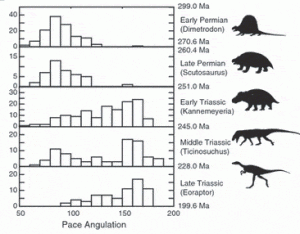 A simple measure to distinguish sprawlers from erect walkers is the pace angulation, the angle formed by three continuous front or hind footprints (figure left), a measurement proposed previously (Peabody 1959), but not rigorously tested on living animals. In our study, we measured pace angulation for 56 species of modern mammals, 69 species of birds, 14 species of lizards, 5 species of turtles, a crocodile, and 14 species of salamanders, and they found that these formed two distinct groups, separating the erect-walking mammals and birds from the other sprawling animals. The crucial finding was that sprawlers have a pace angulation less than 107o and erect walkers have values greater than 138 o.
A simple measure to distinguish sprawlers from erect walkers is the pace angulation, the angle formed by three continuous front or hind footprints (figure left), a measurement proposed previously (Peabody 1959), but not rigorously tested on living animals. In our study, we measured pace angulation for 56 species of modern mammals, 69 species of birds, 14 species of lizards, 5 species of turtles, a crocodile, and 14 species of salamanders, and they found that these formed two distinct groups, separating the erect-walking mammals and birds from the other sprawling animals. The crucial finding was that sprawlers have a pace angulation less than 107o and erect walkers have values greater than 138 o.
Having established the method, we then measured pace angulation in 461 fossil trackways of medium to large tetrapods ranging in age from Middle Permian to Late Triassic. The results (see right) show a clear distinction between the Permian samples (top two histograms) and the Triassic samples (lower three histograms) when median values jump from 87.5 (Late Permian) to 139.5 degrees (Early Triassic). The amazing thing is that all tetrapods, whether synapsids or archosaurs, show the same postural shift across the Permo-Triassic boundary. Once the posture had changed, there was no significant change in mean pace angulation through the Triassic. We tested whether the change in pace angulation might relate to some detectable change in mean body size or speed.
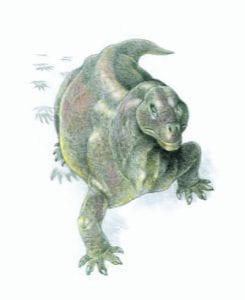 Left: Before the event: the synapsid Moschops sprawls, with knees and elbows held out to the side.
Left: Before the event: the synapsid Moschops sprawls, with knees and elbows held out to the side.
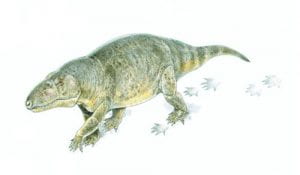 Right: After the event: the basal archosaur Erythrosuchus shows off its upright posture. Both drawings by Jim Robins, copyright.
Right: After the event: the basal archosaur Erythrosuchus shows off its upright posture. Both drawings by Jim Robins, copyright.
The postural shift happened during the 15 myr of the Late Permian (9 myr) and Early Triassic (6 myr). The Early and Late Permian track faunas show almost no definitely erect forms, while most, but not all, Early Triassic forms fall in the convincingly erect range. So, an erect posture apparently swept through terrestrial tetrapod faunas during the 15 myr of the Late Permian and Early Triassic. This is much earlier than indicated by previous studies of locomotory evolution based on skeletal fossils (Charig 1972; Kemp 1982; Bonaparte 1984; Parrish 1987), which suggested that the transition finished some 15-20 myr after the PTB, towards the end of the Middle Triassic. Posture, it seems, changed much more rapidly than the seemingly slow recovery of tetrapods from the end-Permian mass extinction might seem to suggest.
Find out more
The paper: Kubo, T. and Benton, M.J. 2009. Tetrapod postural shift estimated from Permian and Triassic trackways. Palaeontology 52, 1029-1037. pdf.
Press coverage
- University of Bristol press release
- Physorg News
Related web pages

